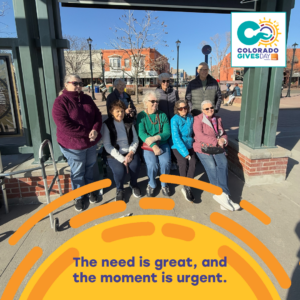DENVER (KDVR) – A Denver-based veterans charity is Serving Those Who Serve. They’re sending grocery gift cards to veterans who are in financial need because of the coronavirus outbreak, and they need your help. Read more
All five of Colorado’s state-run veterans care and nursing home facilities – with more than 450 residents and 500 staffers between them – are without any infection from the new coronavirus among the residents, according to the state Department of Human Services that oversees them. Read more
As the statewide curve of COVID-19 related hospitalizations continues to flatten, Colorado’s stay-at-home order is set to expire Sunday, April 26. But that doesn’t mean that Monday, April 27, we’ll be able to get back to the same way that we were living our lives in January or February. Read more
April 17, 2020
2:00-4:30pm
Objective: Provide clarity and advise steering committee on MHC’s fiscal sponsor process by developing criteria and implementing a selection process that ensures MHC can achieve community impact and adequately resource partners.
The group identified potential barriers in finding potential sponsors and decided MHC should secure a Fiscal Sponsorship Agreement with another party instead of merging with another group.
It is understood that MHC needs to find new funders without competing with our partners.
A list of possible Tier 1, 2 and 3 groups were identified and people in the group were tasked to pre-interview potential funders and, if possible, add more possibilities to the list.
Next steps – At the May Steering Committee meeting present funder criteria and brainstorm with to narrow list of perspective funders and develop a proposal for fiscal sponsers.
The Ride Alliance project is “owned” by DRCOG with funding from CDOT to design and implement a virtual hub to allow paratransit providers and alternative service providers in the greater Denver metro area to share rides. As an example, if SRC had a client who was going to Anschutz Medical Center for a 11 am appointment and AccessARide had a client who was leaving the same location at that time, AccessARide could put their trip into the Ride Exchange Hub, SRC could pull that trip from the Hub and give the AAR client a ride home. The concept is that AAR would save the entire round trip – one way to the hospital empty, and one way from the hospital to the clients home full. SRC would save an empty trip after dropping off their rider by taking the AAR client. This sharing reduces what are known as “deadhead’ trips, cuts vehicle miles traveled in half, frees up all providers to do more trips, and benefits everyone involved. The pilot effort is in production with rides shared between Via Mobility and Broomfield Easy Rides; the whole effort is expected to be in operation by July of 2020. DRMAC is a founding partner.
![DRMAClogo[1] DRMAC](https://drmac-co.org/wp-content/uploads/2019/12/DRMAC20logo1.jpg)




